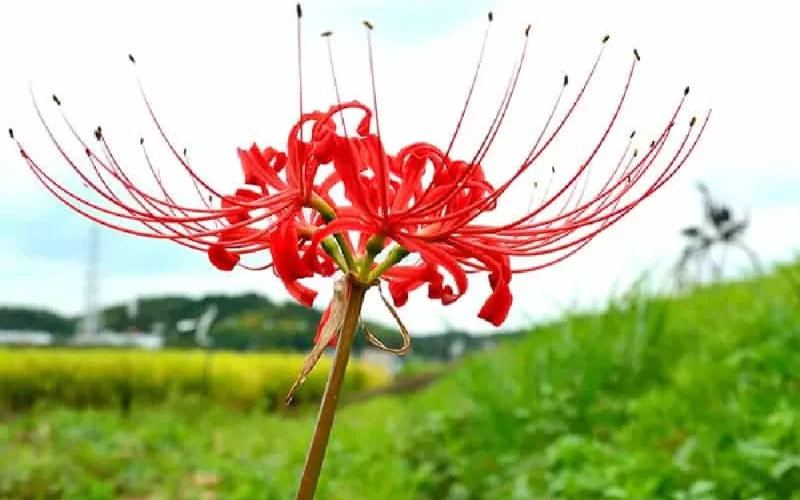Spider lilies are unique flowering plants that stand out in bulbs and perennials.
Growing spider lilies in your home garden can be a rewarding experience.
Especially when you consider how quickly they flower, their low maintenance needs, and their long-lasting, dramatic presence.
These are part of the different types of spider lilies we have. Read on to learn all about this fascinating plant and why you should consider adding it to your garden.
What is a Spider Lily?
Spider lilies are one of the oldest types of plants that are still widely available today.
They have been cultivated by humans for centuries, with origins in Asia. The name spider lily comes from the plant’s large, spider-like leaves.
Moreover, they often grow to about three feet tall but can reach up to six feet.
The flowers themselves grow on single stalks that rise from the base of the plant and bloom one at once.
So, when it does bloom, its petals fan out in all directions from the center of the flower head.
Which is shaped like a spider’s web because of its many layers of white petals reaching toward the sky.
Different Types of Spider Lilies
1. Red Spider Lily
The red Spider lily (Lycoris Radiata) is one of the types of spider lily.
Spider lilies are popular for landscapers because they grow tall, making them easy to spot from afar. This variety grows in red, orange, yellow, and green shades.
The red spider lily, sometimes called a Chinese lantern or Autumn lily, is often used in flower arrangements.
Its long stems are easy to cut, and its petals have a unique shape that makes it stand out. The blooms typically last at least two weeks, and it’s one of the types of spider lilies.
Although they have a reputation for being invasive in some regions, this is not the case with red spider lilies.
However, because of their long roots, spider lilies can be difficult to transplant from one location to another.
Therefore, spider lily seeds are sold in packages of 50 or 100, so it’s important to take care when planting them.
They need a place to receive plenty of sunlight and shade during hot afternoons.
2. Magic Lily
The magic lily (Lycoris squamigera) is a native plant to Japan, China, Taiwan, Korea, and Central Asia.
The name magic lily comes from the flower’s opening at night and closing in the daytime, which is why it’s called a day-night flower.
The flower is also known as a corn spider lily or a tear spider lily. It grows up to 3 feet tall and has glossy leaves that can grow up to 1 foot long.
Moreover, the flowers are either white or red with cream-colored spots. They typically bloom from late summer through early fall.
3. Small Pink Spider Lily
The small pink spider lily (Lycoris sprengeri) is a perennial that blooms in the fall. It is one of the types of spider lilies.
Its flowers are slender and single-stemmed, and the petals are long and thin.
However, the flowers are typically between 2 to 3 inches long with a deep pink color.
But can also come in shades of white or purple. The plant grows up to 8 inches tall, though shorter plants will produce more blooms.
Small spiders are often attached to the flower’s ovary, which gives this type of spider lily its name. And it’s smaller than other types of Lycoris.
The small pink spider lily is perfect for smaller gardens as it produces fewer leaves than other Lycoris species.
4. Orange Spider Lily
Spider lilies are one of the most striking flowers. They’re also known as orange spider lilies (Lycoris Sanguinea), red spider lilies, or yellow spider lilies.
These flowers are known for their large, colorful blooms lasting up to 2 months.
Moreover, the petals on these flowers usually come in shades of red or pink.
But they can be white, yellow, or even purple. The spider lily is perfect for a long-lasting flower with many colors.
How to Grow and Care for the Spider Lily?
Spider lilies are one of the most recognizable plants in the world. You can find them on your dinner plate, in your garden, or strolling through town. But did you know there’s more to a spider lily than meets the eye?
Moreover, spider lilies are perennial plants with long leaves and flower stems that bear their flowers at the end.
The flowers give it its name; they’re shaped like spiders with long, thin petals.
As with many perennials, spider lilies need to be planted in early spring, before new growth appears, or late fall, after the foliage has died back for winter.
Furthermore, all types of spider lilies require well-drained soil and lots of sun. However, they do best when given some shade during the hottest part of the day.
They also prefer having rich, organic soil with plenty of mixed compost. Dig up a wide circle around the spot for best results when planting spider lilies.
That is where you want them to grow, about 18 inches deep. Then loosen up the soil by digging down another 6-8 inches. And plant them within this hole and cover the roots with soil.
However, watch out for pests such as aphids, whiteflies, mites, thrips, and leaf miners. If left unchecked, these can all cause serious damage to these beautiful flowers.
These insects typically come from nearby weeds, so keep your garden clear of unwanted guests! Insecticidal soap and neem oil are both effective ways to get rid of any pesky pests.
Lastly, all types of spider lilies may take a few months to establish themselves fully. But you can be sure that once they do, they’ll stay for years to come.
Conclusion
Spider lilies (Lycoris Radiata) are perennial flowers native to Japan, China, and Korea.
And there are different types of spider lilies. These beautiful blooms grow anywhere from 12 to 20 inches tall.
Their flowers range from pale pink to fiery red, with hints of white throughout the petals and buds.
If you want fresh, unique flowers that can brighten up your home or garden, spider lilies are perfect for you.








